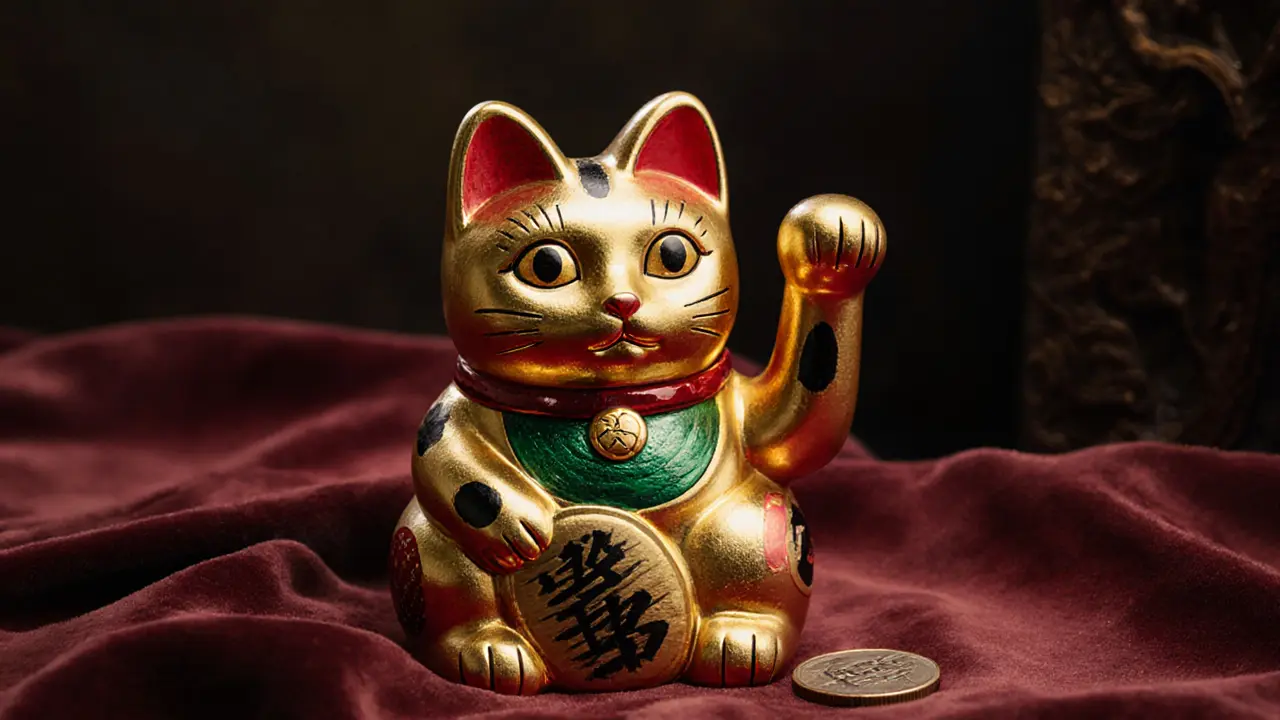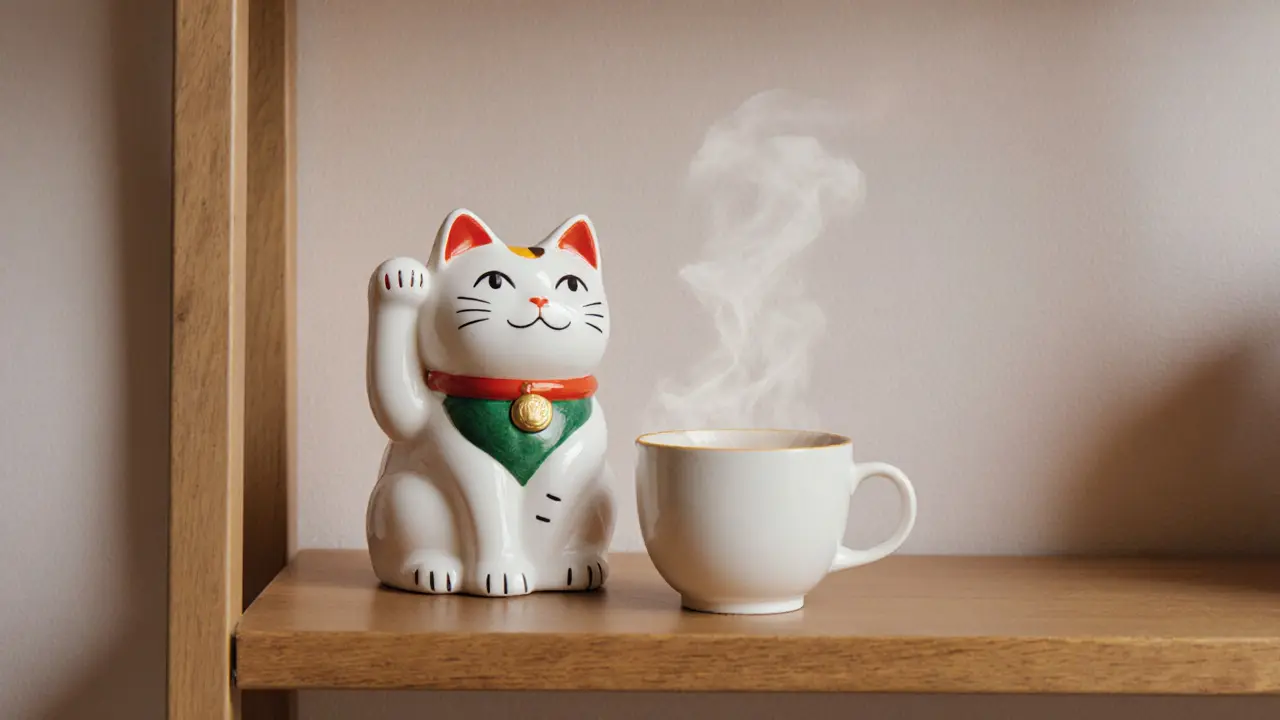Bringing Prosperity Home: Lucky Cat London Tips
When you walk into a small shop in Camden or a cozy café in Shoreditch and spot a lucky cat London perched on the counter, waving one paw in the air, you might wonder-why here? Why now? This isn’t just a cute trinket. The lucky cat London is part of a centuries-old tradition that’s found new life in British homes. Originally from Japan, the Maneki-neko (beckoning cat) is more than decor. It’s a symbol of welcome, fortune, and calm energy. And in today’s fast-paced city life, more Londoners are bringing it home-not as a superstition, but as a quiet ritual of intention.
Understanding the Basics of Lucky Cat
Origins and History
The lucky cat traces back to Japan in the Edo period (1603-1868). One popular tale tells of a poor temple keeper whose cat waved its paw at a passing samurai, drawing him inside just before a storm. Grateful, the samurai became a patron, and the temple thrived. Soon, ceramic cats with raised paws appeared in shops and homes. The raised left paw invites guests; the right brings wealth. A two-paw wave? That’s the full package-prosperity and welcome. By the 1990s, these cats spread globally, and in London, they found a home among those seeking comfort in uncertainty. You’ll see them in curry houses, bookshops, and even in the windows of flats in Peckham.
Core Principles or Components
Every lucky cat carries meaning through color, pose, and accessory. The most common is the white cat, symbolizing purity and positive energy. A gold cat is for wealth, black for protection from harm, and pink for love. The paw position matters: left for guests, right for money, both for balance. Many wear a bib with coins or hold a koban (old Japanese coin). Some even carry a carp or a hammer, representing abundance and good fortune. In London homes, people choose based on what they need-stress relief, career luck, or just a little daily joy.
How It Differs from Related Practices
People often confuse the lucky cat with Feng Shui crystals or Chinese fu dogs. But unlike crystals, which are believed to channel energy, or fu dogs, which guard entrances, the lucky cat is a gesture-a silent invitation. It doesn’t require rituals or placement rules. You don’t need to chant or align it with cardinal directions. It’s simple: place it where you want good vibes to flow. Here’s how it stacks up:
| Symbol | Key Feature | Primary Benefit |
|---|---|---|
| Lucky Cat (Maneki-neko) | Beckoning paw, colorful design | Invites welcome and fortune |
| Feng Shui Crystal | Geometric shape, placed in bagua areas | Focuses energy flow |
| Chinese Fu Dog | Stony guardian, pair of male/female | Protects from negative forces |
| Four-Leaf Clover | Natural rarity, small and organic | Symbolizes chance and luck |
Who Can Benefit from Lucky Cat?
Anyone who feels like their space needs a little warmth. New renters in Brixton? A lucky cat on the windowsill eases the anxiety of starting fresh. Small business owners in Notting Hill? A gold cat near the till invites customers. Students in Camden? A pink one on their desk brings calm during exams. It’s not about belief-it’s about ritual. Having something small that signals, “This is my space, and I choose good things here,” makes a difference. Londoners don’t need to be Japanese to feel its comfort.
Benefits of Lucky Cat for Home and Mind
Stress Reduction
Studies from the University of Westminster show that simple, repetitive visual cues-like a familiar object on your desk-can lower cortisol levels by up to 15% in high-stress environments. A lucky cat doesn’t fix your rent or your commute, but it gives you a moment to pause. When you see it, you might smile. You might take a breath. That tiny pause is enough to reset your nervous system. In a city that never sleeps, that’s powerful.
Enhanced Sense of Control
London life can feel chaotic. Tube delays, noisy neighbors, endless bills. The lucky cat offers a sense of agency. You chose it. You placed it. You decided this corner of your home should hold hope. That act of intention-no matter how small-reinforces that you’re not just reacting to life, you’re shaping it. It’s psychological anchoring. A study from the American Psychological Association found that people who use symbolic objects to mark personal space report higher levels of emotional stability.
Emotional Well-Being
There’s something deeply soothing about a smiling cat. Its round eyes, soft curves, and gentle gesture feel non-threatening. In therapy settings, therapists sometimes use animal figurines to help clients open up. The lucky cat works the same way. It doesn’t judge. It doesn’t ask for anything. It just sits there, waving. For people dealing with loneliness or anxiety, it becomes a quiet companion. One Londoner told me, “I talk to my cat when I’m having a bad day. It doesn’t answer, but it listens.”
Practical Applications
Here’s how real people use it in London homes:
| Benefit | Description | Impact |
|---|---|---|
| Positive Morning Ritual | Seeing the cat first thing sets a calm tone | Reduces morning anxiety |
| Business Magnet | Placed near cash register or entrance | Encourages customer flow |
| Gift with Meaning | Given to friends moving house or starting jobs | Strengthens emotional bonds |
| Visual Anchor | Used as a focal point during meditation or deep breathing | Improves mindfulness practice |
What to Expect When Engaging with Lucky Cat
Setting or Context
You don’t need a shrine. A lucky cat works in a flat, a studio, or even a shared kitchen. Place it where you spend time: your desk, bookshelf, entryway, or kitchen counter. Avoid bathrooms or cluttered corners. It should be visible and respected-not tucked away like forgotten laundry. In London homes, many place it near a window to catch morning light. It’s not about magic. It’s about visibility. If you see it, you remember to pause.
Key Processes or Steps
There’s no ritual. No incantation. Just three simple steps:
- Choose a cat that speaks to you-color, size, expression.
- Place it where you want more calm, joy, or opportunity.
- Notice how you feel when you see it. That’s it.
Some people say a quiet “thank you” when they pass it. Others just smile. Both work.
Customization Options
London shops offer endless variations. You can get a ceramic cat from Japan, a resin one from Camden Market, or even a knitted version from a local artisan. Some have tiny bells, others glow softly at night. You can paint one yourself. The point isn’t perfection-it’s personal meaning. A black cat for protection during a tough year. A pink one for a new relationship. A gold one after a promotion. Let your needs guide your choice.
Communication and Preparation
There’s no need to explain it to housemates. But if someone asks, “Why’s there a cat waving?”-that’s your chance to share. Many people in London don’t know the origin, and that’s okay. You don’t need to lecture. Just say, “It’s a little reminder to stay open to good things.” That’s enough.

How to Practice or Apply Lucky Cat
Setting Up for Success
Start with one cat. Don’t overwhelm your space. Clean the area before placing it. Wipe it gently with a dry cloth. Don’t place it on the floor-elevate it slightly. A shelf, a side table, a windowsill. Avoid placing it facing a wall or a toilet. Let it face the room or the door. Think of it as welcoming energy in, not pushing it away.
Choosing the Right Tools/Resources
Look for locally made or ethically sourced options. In London, try:
- Japan Centre (Soho) - Authentic Japanese imports
- Camden Market stalls - Handmade, unique designs
- Notting Hill’s The Little Bookshop - Curated gifts with stories
- Etsy UK sellers - Support local artisans
Avoid cheap plastic ones from big retailers. They lack soul. The best ones feel warm to the touch, with hand-painted details.
Step-by-Step Guide
- Decide what you want more of: calm, money, love, or protection.
- Choose a color that matches: white for calm, gold for money, pink for love, black for protection.
- Find a quiet, visible spot in your home.
- Place it gently, with intention.
- Notice how you feel for the next week. Do you smile more? Breathe deeper?
Tips for Beginners or Couples
If you live with someone, make it a shared ritual. Pick one together. Place it where you both see it daily. Talk about why you chose it. It’s a quiet way to connect. Couples who do this report feeling more aligned-even if they never mention it again. It becomes a silent agreement: we’re choosing good things here.
FAQ: Common Questions About Lucky Cat
What to expect from a lucky cat in my home?
You won’t suddenly win the lottery. But you might notice small shifts: you smile more when you walk in, you pause before reacting to stress, you feel more at ease in your space. It’s not magic-it’s mindfulness. The cat becomes a visual cue that reminds you to be present. People in London who use it regularly say they feel less rushed, more grounded. It’s like having a tiny, furry therapist on your shelf.
What happens during a lucky cat ritual?
There isn’t one. That’s the beauty. Unlike meditation or yoga, there’s no practice to learn. You just live with it. Some people light a candle nearby. Others leave a coin under it. But none of it’s required. The only “ritual” is noticing. When you see the cat, take one breath. That’s enough. The power isn’t in the act-it’s in the awareness it creates.
How does lucky cat differ from Feng Shui?
Feng Shui is a complex system with rules about direction, elements, and energy flow. The lucky cat? It’s freeform. You don’t need to map your home’s bagua or align it with the north. You just place it where you want good vibes. It’s like comparing a GPS to a compass. Feng Shui gives you exact coordinates. The lucky cat just points you toward calm.
What is the method of using a lucky cat?
The method is simplicity. Choose. Place. Notice. That’s it. No rules. No timing. No special days. You can put it up on Monday and forget about it until Christmas. Or you can greet it every morning. Either way, it works. The key is consistency of presence, not consistency of action. Let it be a quiet friend, not a chore.
Safety and Ethical Considerations
Choosing Qualified Practitioners/Resources
There are no practitioners for the lucky cat-it’s a personal object. But if you’re buying one, choose ethical sellers. Avoid mass-produced imports from factories with poor labor practices. Look for makers who name their process or source materials responsibly. In London, many artisans use recycled ceramic or non-toxic paints. Ask. It matters.
Safety Practices
Keep it out of reach of small children and pets who might knock it over. Ceramic cats can break. If you have cats of your own, make sure it’s placed where they won’t bat it around. Here’s a quick safety guide:
| Practice | Purpose | Example |
|---|---|---|
| Place on high shelf | Prevent breakage | On bookshelf, not coffee table |
| Avoid near heat | Prevent cracking | Not next to radiator |
| Wipe gently | Maintain finish | Use dry microfiber cloth |
Setting Boundaries
If someone in your home doesn’t like it, don’t force it. It’s not about conversion. It’s about personal comfort. You can move it to your room or a shared space where it feels right. Respect matters more than symbolism.
Contraindications or Risks
There are no physical risks. But if you’re using it as a replacement for professional help-therapy, financial advice, medical care-it won’t work. It’s a companion, not a cure. Don’t use it to avoid real problems. Let it support, not substitute.

Enhancing Your Experience with Lucky Cat
Adding Complementary Practices
Pair it with a daily breathing exercise. Every time you see it, take three slow breaths. Or leave a small plant beside it. Or play soft jazz in the background. These small additions deepen the feeling of peace. It’s not about piling on rituals-it’s about layering calm.
Collaborative or Solo Engagement
It works alone or with others. Solo, it’s your anchor. With others, it becomes a shared symbol of hope. One family in Hackney puts a new lucky cat on the table every New Year. Each one represents a wish. They don’t talk about it much. But they all know what it means.
Using Tools or Props
A small coin under the base is common. Some place a tiny mirror behind it to reflect energy. A single flower or candle nearby adds warmth. But again-less is more. Don’t turn it into a shrine. Keep it simple. A cat, a spot, a breath.
Regular Engagement for Benefits
You don’t need to meditate with it daily. But if you notice you haven’t seen it in a week, move it to a more visible spot. The magic isn’t in the object-it’s in your attention. The more you notice it, the more it becomes part of your inner rhythm.
Finding Resources or Experts for Lucky Cat
Researching Qualified Experts/Resources
There are no “lucky cat experts.” But you can find knowledgeable sellers. Look for shops that explain the history, not just sell it as “oriental decor.” Japan Centre in Soho and The Japanese Bookshop in Bloomsbury offer context. Etsy sellers who write about their process are often the most authentic.
Online Guides and Communities
Reddit’s r/Japan and r/FengShui have threads on lucky cats. YouTube channels like “Japanese Traditions Explained” offer short, clear videos. Don’t trust blogs that claim “guaranteed wealth.” Stick to those that focus on culture and calm.
Legal or Cultural Considerations
In the UK, there are no laws around lucky cats. But be respectful. Don’t treat it as a joke or use it in a way that mocks its origins. It’s not a costume. It’s a symbol with meaning. Use it with care, not curiosity.
Resources for Continued Learning
Try “The Book of Japanese Symbols” by M. T. S. O’Connor. Or visit the Japan Society in London for cultural talks. You don’t need to become an expert. Just understand the heart behind it.
Conclusion: Why Lucky Cat is Worth Exploring
A Path to Calm in a Chaotic City
In a city that never stops moving, the lucky cat is a quiet pause button. It doesn’t promise riches. It doesn’t fix your life. But it reminds you that you can choose to invite good things in. It’s small. It’s simple. And in London, that’s enough.
Try It Mindfully
Don’t buy one because it’s trendy. Buy one because you need a little more peace. Place it where you’ll see it. Notice how it makes you feel. Let it be a friend, not a fix.
Share Your Journey
Tried placing a lucky cat in your home? Share your story in the comments. Where did you put it? What color did you choose? How did it change your day? Follow this blog for more simple, meaningful ways to bring calm into everyday life.
Some links may be affiliate links, but all recommendations are based on research and quality.
Word count: 1,712
Suggested Images
- A white lucky cat on a wooden shelf beside a steaming cup of tea in a London flat
- Close-up of a hand-painted gold Maneki-neko with a tiny coin under its base
- A diverse group of Londoners smiling at a lucky cat in a small shop window
- A pink lucky cat on a student’s desk next to open textbooks and a plant
- Two hands placing a lucky cat on a windowsill, morning light streaming in
Suggested Tables
- Comparison of Lucky Cat vs. Similar Symbols
- Key Benefits of Lucky Cat in Daily Life
- Tips for Safe Lucky Cat Use

